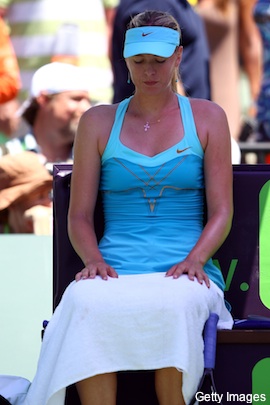Patrick Mouratoglou is a world-renowned tennis coach who has worked with Marcos Baghdatis and Aravane Rezai. His French tennis academy is considered one of the top in the world. He is a frequent contributor to Busted Racquet.
Though Maria Sharapova's quest to win the Sony Ericsson Open ended in Saturday's final to Victoria Azarenka, I was struck at how much progress the Russian star has come in the past year and how far she still has to go.
Sharapova was electrifying on her way to the final, showing glimpses of greatness in between bouts of weakness. She's still young, but after going through a lot of injuries, including a right shoulder surgery, I still don't know if tennis is her top priority.
It may sound strange to talk about weakness in a player reaching a final in a top event like Miami, but I insist that Maria Sharapova is far from having found her A game. She built her strength around several main weapons: a big serve, being efficient in the first shot after it and putting a lot of intensity in returning. (That kept her opponent under constant pressure in return games.) The problem is that serve though, especially the second ones. She needs to be reminded constantly by her coach to be more aggressive with it.
The second serve is amazingly unreliable and results in many double-faults and a curious number of breaks. It leads to her playing a less aggressive game with less power and explosivity in her moves. Now she's making as many enforced errors as before but far fewer winners.
Most important, she became a beatable player once you know the strategy to set up against her. She remains dangerous when you give her angles. She likes to be moved around the court because she can use it to fire some great shots down the lines. In a womens' tennis game where numerous girls are playing from right to left in reasonable speed, the Russian can take advantage. But if an opponent does the opposite and plays deep balls in the middle of the court, Sharapova doesn't know how to strike back. She forces mistakes, which leads to counterpunching by an opponent.
Maybe I'm harsh. She is still winning matches, of course. How? First, as I've said, her efficiency is tied to the fact that most of the other players' games suit her. Then, she remains one of the best for returning serves, so she's putting a lot of pressure on her opponents that way. Finally, she's a huge competitor, a player who gets tough when the key points come, a player who never chokes when it's time to end a match and someone who is going to take her chance no matter what, from the first point to the last. She's still fighting like her life is at stake. Because of that, she's back in the top 10.
It's thrilling to watch the beautiful Maria winning and getting back in the spotlight. Her charisma, the feeling she gives people watching her play, is just unique. She's displaying he great inner strength. She makes people dream and love the sport.� But is she motivated?
What allows Rafael Nadal and Roger Federer to achieve so much is their love of the game and their dedication to it. They still have the flame so they can go on training and searching to get better in order to win. They still want to win. And they deeply respect our sport, its history and culture.
Celebrity, glamour, sponsoring contracts take now too much place in the women's game and it takes away the stars of a sport that brought them at the top. They're losing their focus and their game's level is becoming unpredictable so they're prevented from shining in the big events. The absence of giant fights, from Maria to the Williams sisters to Ivanovic and Safina, is what's slowly killing their sport.
Alicia Witt Radha Mitchell Melissa Rycroft Chloë Sevigny Janet Jackson

No comments:
Post a Comment